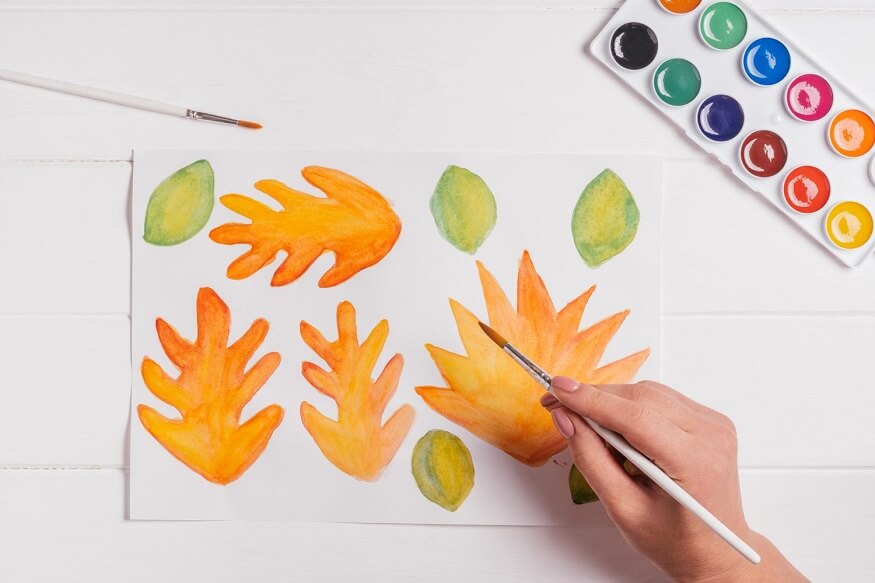Making leaf paintings and sketches is a wonderful way to introduce kids to nature and spark their imaginations. These interesting and entertaining activities may be modified for kids of different ages and just call for a few simple ingredients. For the little ones, here is a tutorial on how to make leaf art and doodles.
Also Read: Collaborative Art Projects for Kids and Parents
Materials Needed
To start with, you need to gather your materials. These include leaves of various shapes and sizes, drawing paper, crayons or coloured pencils, paint (optional), paintbrushes (optional), and a glue stick. If you decide to use paint, ensure that it’s child-friendly and non-toxic.
Step 1: Collecting Leaves
Begin by going on a nature walk with your children. This could be in your garden, a local park, or a nearby woodland. Encourage your children to observe the different types of leaves around them – their shapes, sizes, colours, and textures. Collect a variety of leaves, making sure to only pick up ones that have already fallen to the ground.
Step 2: Preparing the Leaves
Once you have collected your leaves, they need to be prepared for art-making. Some leaves may be used as is, but others may need to be pressed and dried. To do this, simply place the leaves between two sheets of paper or in a heavy book. After a few days, they should be flat and dry.
Step 3: Leaf Rubbing Art
One of the simplest and most engaging leaf art activities is leaf rubbing. Place a leaf under a sheet of paper, with the vein side facing up. Have your child use a crayon or coloured pencil to lightly rub over the leaf. The outline and details of the leaf will be revealed on the paper. Encourage your children to experiment with different colours and leaf types.
Step 4: Leaf Painting
Another creative activity involves painting the leaves. Help your child apply paint to the vein side of a leaf. Then, press the painted side onto a sheet of paper. Carefully lift the leaf to reveal a beautiful leaf print. This can be done with several leaves of different sizes and colours to create a colourful masterpiece.
Step 5: Leaf Collage
For a leaf collage, your child can arrange dried leaves on a sheet of paper in any design they like. They could create a forest scene, a leafy animal, or a beautiful abstract arrangement. Once they’re happy with their design, help them glue the leaves in place.
Step 6: Drawing From Observation
This activity encourages children to develop their observational skills. Ask your child to pick a leaf they find interesting and then draw it on a piece of paper. Encourage them to look closely at the leaf, noticing its shape, the patterns of its veins, and any unique features. They can then colour the drawing using their crayons or coloured pencils.
Step 7: Creating Leaf Characters
Let your children’s imagination run wild by turning leaves into characters. Leaves can become bodies, wings, or clothing of fairies, monsters, animals, or any other creature your child can dream up. Draw additional elements like faces, arms, or legs, then colour and cut them out to stick with the leaves on paper.
Also Read: Origami paper buying guide
Lеaf Art Exhibition
Finally, display your child’s lеaf art and drawings around thе housе. This not only cеlеbratеs thеir crеativе work but also hеlps boost thеir confidеncе. You could also photograph thеir work and crеatе a digital gallеry or еvеn sharе it with family and friеnds onlinе.
It’s not about crеating pеrfеct art. It’s about thе procеss and thе еxploration. So, lеt your childrеn еxpеrimеnt, makе ‘mistakеs’, and, most importantly, havе some fun. Aftеr all, еvеry lеaf, likе еvеry child, is uniquе and bеautiful in its own special way.
Also Read: Creative Art Projects for Kindergarteners: Exploring Colours and Shapes
What do children learn from leaf painting?
Leaf art and drawing activities provide a hands-on, creative way to explore the natural world. They help children develop fine motor skills, observational skills, and an appreciation for nature. Additionally, they open up opportunities for learning – you can teach your children about different types of trees, the changes in seasons, and the cycle of life. More importantly, they’re fun and allow you and your child to spend quality time together. Leaf painting offers a variety of learning opportunities for children, providing them with the chance to gain a range of skills and insights.
Nature Appreciation: Children learn to appreciate the beauty of the natural world. They observe the details of leaves — their shapes, textures, colours, and the intricate vein patterns. This process encourages a sense of wonder and respect for nature.
Fine Motor Skills: Leaf painting helps children develop their fine motor skills. Manipulating the paintbrush and carefully pressing the leaf onto paper require control and coordination.
Creativity and Imagination: Leaf painting promotes creativity as children are free to choose their colours, the arrangement of their leaf prints, and any additional elements they might wish to incorporate into their art.
Observation Skills: By closely examining leaves to decide how and where to paint them, children enhance their observational skills. They learn to pay attention to details and similarities or differences among the leaves.
Scientific Concepts: Leaf painting can serve as a springboard for learning about various scientific concepts, such as photosynthesis, the changing seasons, or why leaves come in so many different shapes and sizes.
Patience and Focus: The process of painting leaves and pressing them onto paper requires patience and concentration. These are valuable skills that can be applied to other areas of learning.
Emotional Expression: Art activities like leaf painting provide a medium for children to express their feelings. The choice of colours and designs can reflect their moods and emotions.
Spatial Awareness: Children gain a better understanding of concepts like size, space, and orientation as they decide where and how to place their leaves on the paper.
Decision-making Skills: Children make a series of decisions during leaf painting, such as which leaves to paint, what colours to use, and how to arrange the leaves. This fosters independence and critical thinking skills.
Cross-Cultural Awareness: Leaf painting can be used as an opportunity to teach children about different cultures and traditions. For example, the autumn leaf viewing (Koyo) in Japan is a cultural activity where people admire the changing colours of leaves. Or you could discuss Aboriginal art from Australia that incorporates elements from nature, including leaf shapes. In this way, children learn to appreciate the diversity of the world around them, fostering open-mindedness and cultural awareness.
Also Read: The Role of Arts Education in a Well-Rounded Curriculum
Through lеaf painting, childrеn lеarn in a fun, еngaging way. Thе activity makеs lеarning hands-on and mеaningful, еnhancing not only thеir knowlеdgе but also thеir lovе for lеarning.
EuroSchool studеnts havе rеgular opportunitiеs to participatе in art and craft activitiеs, both in thе classroom and in еxtracurricular clubs. This hеlps to еnsurе that all studеnts havе thе opportunity to еxplorе thеir crеativity and to dеvеlop thеir artistic skills.









